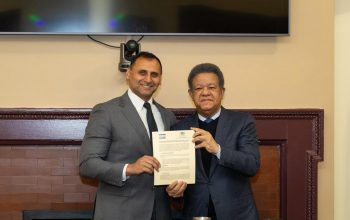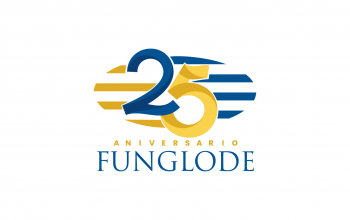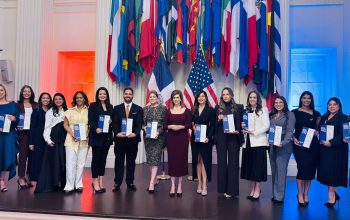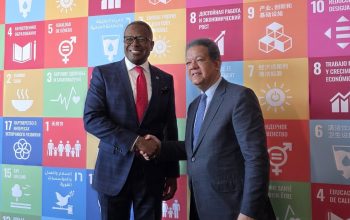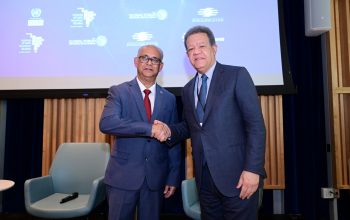news
National Meeting on Marine Mammals Yields Numerous Positive Outcomes
July 1, 2009
The National Meeting on Marine Mammals, held on June 29, assessed the current state of marine mammals in the Dominican Republic and delineated steps to be taken in the areas of research, conservation and protection to assure the continued existence of whale, dolphin and manatee populations living in the territorial waters of the Dominican Republic. The meeting was
organized by Global Foundation for Democracy and Development (GFDD) and its sister institution in the Dominican Republic, Fundación Global Democracia y Desarrollo(FUNGLODE), in partnership with ATEMAR.
organized by Global Foundation for Democracy and Development (GFDD) and its sister institution in the Dominican Republic, Fundación Global Democracia y Desarrollo(FUNGLODE), in partnership with ATEMAR.
The meeting, held at FUNGLODE headquarters in Santo Domingo, united a
large number of national and international experts in the area of marine mammal conservation, in order to assess the current status of marine mammal populations in the Dominican Republic. Participants represented organizations that have conducted work in the Dominican Republic in the areas of research, conservation and protection throughout the last 23 years. Participating organizations included: the National Oceanic and Atmospheric Administration (NOAA) represented by Dr. Phil Clapham; Dr.
John Reynolds, Chairman of the Marine Marine Commission; Dr. Chris Clark, Director of the Bio-Acoustics in the Neurology and Behavior Science Department at Cornell University; Dr. Danielle Cholewiak, from the Stellwagen Bank National Marine Sanctuary; Professor David Mattila, Coordinator of the Hawaiian Islands Humpback Whale National Marine Sanctuary; Eleuterio Martínez, Deputy Minister for Protected Areas and Biodiversity of the Environment and Natural Resources Ministry; Omar
Ramírez, Director of the National Commission for Climate Change; Dr. Idelisa Bonnelly de Calventi, Director of the Marine Biology Research Center (CIBIMA) of the Autonomous University of Santo Domingo and President of the Dominican Foundation for Marine Research (FUNDEMAR); as well as representatives from Ecomar and The Nature Conservancy.
large number of national and international experts in the area of marine mammal conservation, in order to assess the current status of marine mammal populations in the Dominican Republic. Participants represented organizations that have conducted work in the Dominican Republic in the areas of research, conservation and protection throughout the last 23 years. Participating organizations included: the National Oceanic and Atmospheric Administration (NOAA) represented by Dr. Phil Clapham; Dr.
John Reynolds, Chairman of the Marine Marine Commission; Dr. Chris Clark, Director of the Bio-Acoustics in the Neurology and Behavior Science Department at Cornell University; Dr. Danielle Cholewiak, from the Stellwagen Bank National Marine Sanctuary; Professor David Mattila, Coordinator of the Hawaiian Islands Humpback Whale National Marine Sanctuary; Eleuterio Martínez, Deputy Minister for Protected Areas and Biodiversity of the Environment and Natural Resources Ministry; Omar
Ramírez, Director of the National Commission for Climate Change; Dr. Idelisa Bonnelly de Calventi, Director of the Marine Biology Research Center (CIBIMA) of the Autonomous University of Santo Domingo and President of the Dominican Foundation for Marine Research (FUNDEMAR); as well as representatives from Ecomar and The Nature Conservancy.
The National Meeting on Marine Mammals made clear the key role the Dominican Republic has played as a world leader in the conservation of these species, as it was the first in the region to establish the Silver Bank Humpback Whale Sanctuary in 1986, in order to protect the mating, calving and nursery grounds of humpback whales (Megaptera novaeangliae). Since then the country has followed suit as a
global pioneer, establishing the first "sister sanctuary" arrangement between the NOAA Stellwagen Bank National Marine Sanctuary off the coast of Massachusetts and the Marine Mammal Sanctuary of the Dominican Republic, two marine protected areas 1,500 miles apart that provide conservation programs for the North Atlantic
humpback whale population on both ends of its range. It is estimated that the Marine Mammal Sanctuary of the Dominican Republic, which presently covers a 19,438-square-mile area including Navidad Bank and part of Samana Bay, receives an estimated 17,000 humpback whales per year, making it the area of highest density of this species of whales in the world.
global pioneer, establishing the first "sister sanctuary" arrangement between the NOAA Stellwagen Bank National Marine Sanctuary off the coast of Massachusetts and the Marine Mammal Sanctuary of the Dominican Republic, two marine protected areas 1,500 miles apart that provide conservation programs for the North Atlantic
humpback whale population on both ends of its range. It is estimated that the Marine Mammal Sanctuary of the Dominican Republic, which presently covers a 19,438-square-mile area including Navidad Bank and part of Samana Bay, receives an estimated 17,000 humpback whales per year, making it the area of highest density of this species of whales in the world.
Outcomes of National Meeting on Marine Mammals:

